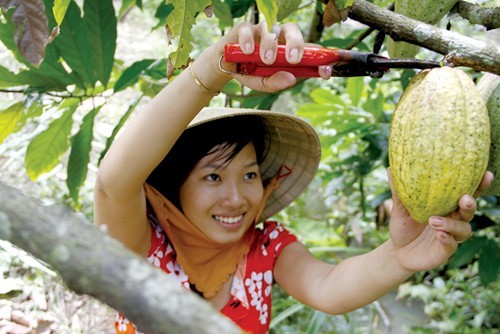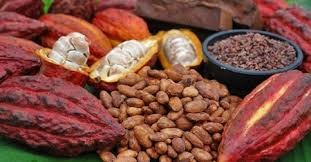(VOVworld) – Vietnamese possesses some favorable microclimates for growing cocoa. Cocoa trees are grown in the central highlands and the southwestern region, where the climate is neither too hot nor too cold. Realizing Vietnam’s potential for cocoa, in 2008, Puratos Grand Place, a Belgium group, started a model called“From farming to chocolate” in Vietnam, using Vietnamese cocoa to produce made-in-Vietnam chocolate.
 |
| (Photo: doanhnhansaigon.vn) |
Cocoa trees were introduced into Vietnam a long time ago, but farmers at first grew them unprofitably on a family scale. Vietnam’s Mekong Delta and Central Highlands regions are now major cocoa-producing regions. Phan Thi Phuong Thanh, Marketing Manager in Puratos Grand Place Vietnam, said:
"In Vietnam, farmers often lack accurate information about the value of cocoa trees. When they think that other trees are more profitable, they give their land over to growing oranges, grapefruits, and mandarin oranges. When they see a great demand for cocoa, they re-plant cocoa trees. This leads to instability in the cocoa supply in Vietnam".
In 2008, Puratos Grand Place began working with farmers in the Mekong River Delta area, conducted research on cocoa cultivation, and started a program to develop cocoa trees sustainably in Vietnam. Today, the world’s consumption of chocolate is rising while production is decreasing, so it is time to create a stable source of cocoa. Pierre Le Hegarat of France is the business development manager at Puratos Grand Place Vietnam: "Today, the consumption is increasing. For example, in France, an average about 7 kilo per person per year, If you go to Switzerland, it’s about 11 kilo per person per year. Europe is a big consumer of cocoa and chocolate. What you have to know, you have to . One cocoa tree can give you every year one kilo of cocoa".
The model “From farming to chocolate” focuses on the farmers who are directly involved in growing the cocoa. The program teaches them advanced growing and cocoa beans processing techniques to boost quality. It requires a meticulous process to produce a great bar of chocolate. It involves many steps - growing, drying the beans, fermentation, roasting, and not many farmers know how to do this properly: "In Vietnam, many people ferment in their own way. Many farmers after harvesting cocoa beans, they leave on the two sides of the road, the quality of the cocoa beans is not good, because it’s rotten".
The farmers are trained in growing techniques, fermentation, roasting, and grinding to produce the cocoa powder needed to make chocolate: "In Ben Tre province, we have a collection and fermentation center. In this center, we welcome all the farmers, we work with them on the technique of cocoa tree, how to grow the tree. Because you know, cocoa tree is very sensitive with the sun with the rain, so you have to grow something like forest to protect the cocoa tree".
Farmers receive up-to-date market information on cocoa. To improve the quality of seedlings and cocoa beans, the program also provides farmers with tools and equipment such as incubators and drying platforms. The farmers are encouraged to take better care of their plants and improve their productivity through a “chocolate bonus” program. Ms. Phuong Thanh again: "In addition to revenue, under Cacao Trace, our program to promote long-term cocoa production and sustainable development, we have the “chocolate bonus” program. If the farmers’ products meet the set quality requirements, we give them a bonus to encourage them to produce high-quality cocoa and improve their productivity".
 |
| (Photo: thoibaonganhang.vn) |
The program benefits more than 2,000 farmers who collectively produce 50 percent of Vietnam’s cocoa. Vietnamese cocoa combined with Belgian know-how, and equipment, is producing higher-quality Vietnamese chocolate. The “farming to chocolate” model has created a more sustainable cocoa supply and has boosted productivity and incomes for farmers in the Mekong Delta and central highland regions. Do Nam is a farmer who lives in Tra Vinh province: "Today we receive much better guidance on how to take care of cocoa trees. This has considerably improved our cocoa productivity and quality".